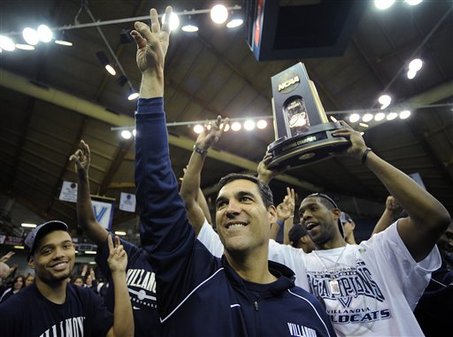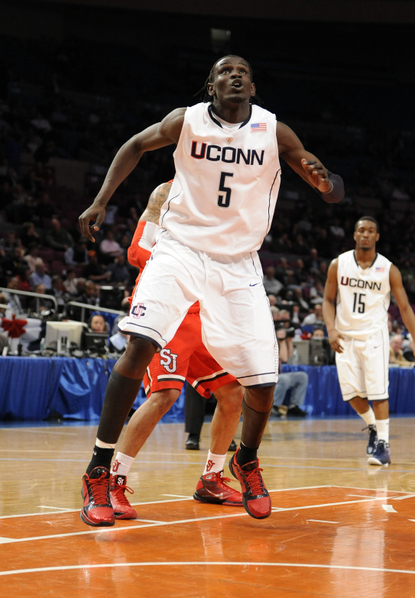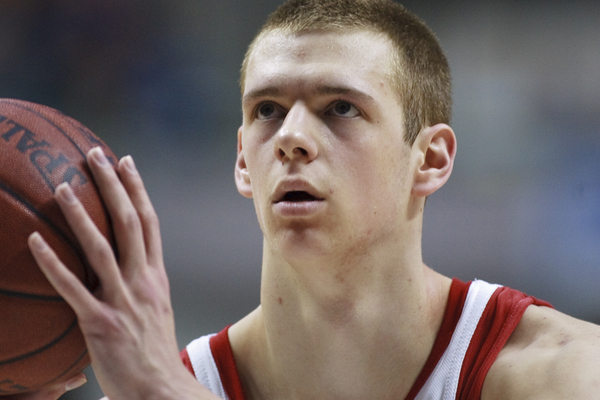Zach Hayes is an editor, contributor and bracketologist at Rush the Court.
For the entire 20 At The Top series, click here.
There’s little doubt remaining that the Big East is the superpower college basketball league. When it’s pegged as the premiere conference prior to the season, it always seems to live up to the hype. When prognosticators predict its decline, it surprises us all and we’re left wondering why we underestimated the Big East again. Some team like Syracuse of last year emerges and elevates the conference to higher levels. Even with record-breaking seniors such as Scottie Reynolds, Luke Harangody and Da’Sean Butler moving on and lottery picks Wesley Johnson and Greg Monroe also departing, the Big East should be strong once again in 2010-11. The fight at the top will likely pit Villanova, Pittsburgh, Georgetown, Syracuse and a sleeper that’s yet to be determined. As I did with the ACC and Big 12, here are your top 20 players heading into next season in what could be a guard-dominated Big East:
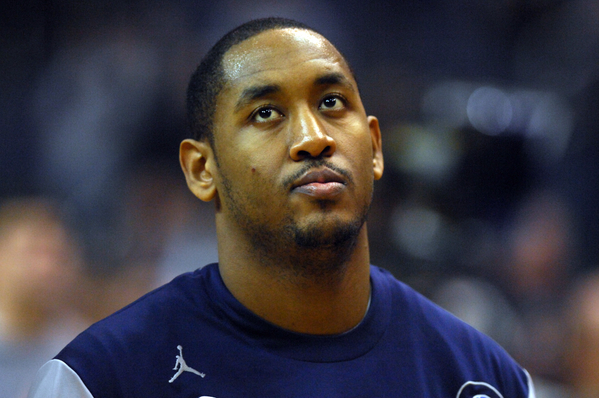
In a close race, Freeman is the best of the pack
1) Austin Freeman, Georgetown– I had a difficult time ranking the top six in this list before ultimately settling on Freeman at the top spot for a handful of reasons, notably perimeter shooting, efficiency and basketball IQ. He had the least question marks and negatives to his game than any of the other candidates. Freeman emerged as a sharpshooting weapon in Big East play for an up-and-down Hoyas team. Some may credit his career high three point percentage on defenses keying on Greg Monroe, but 44% is still a fantastic total even shooting alone in an open gym. Freeman utilizes his strong frame to fight around screens for open looks and possesses a picture perfect shooting stroke. One has to be intelligent on the basketball court if you want to play for John Thompson III; Freeman limits his turnovers and ranked near the top of the Big East in both offensive rating and efficient FG%. Where Freeman can improve during his senior year is using that frame to be more aggressive to the rim. Shooting under 100 free throws on the season isn’t going to suffice with the Hoyas lean frontcourt depth. Having an entire summer to deal and manage with his diabetes- a possible factor for his fading down the stretch last season- will certainly help to a degree.
2) Corey Fisher, Villanova– It’s now Corey Fisher’s team at Villanova. With Scottie Reynolds’ decorated four seasons a thing of the past, Fisher will play the lead role in 2010-11 for Jay Wright. The expectation doesn’t change perennially for Wright-coached teams along the Main Line: contend for the Big East crown. Fisher is a tough kid from the Bronx that should be able to shoulder such pressure. The 6’1 speedster has improved through each of his three seasons in Philly, bumping his FG% up to a solid 45% clip as a junior, remaining dependable at the charity stripe and greatly increasing his three-point shooting to nearly 40%. His floor skills and court vision also lead me to believe he can handle running the up-tempo Nova attack and he continues to be a headache to try to defend. His spot-up jump shooting has always been a strength and Fisher also features a series of tricky floaters, up-and-under moves in the paint and an impressive dribble-drive repertoire. The only caveat: a five-minute suspension in Villanova’s first round NCAA Tournament game last March does bring maturity into question.
3) Kevin Jones, West Virginia– Jones has come a long way from two summers ago when his home state Syracuse Orange wouldn’t even offer him a scholarship. Now faced with the departure of Da’Sean Butler and Devin Ebanks, Jones knows head coach Bob Huggins is expecting him to be the featured offensive threat for the Mountaineers. A tremendously hard worker on and off the floor, KJ improved his game in every capacity from his freshman to sophomore campaigns and was an under-appreciated player nationally during West Virginia’s Final Four run. He was a huge factor in WVU finishing second in the nation in offensive rebounding, upped his three point percentage from 21% to 40% and his PPG more than doubled as a result. The 6’8 power forward plays bigger with a lengthy wingspan and tremendous energy. His turnover rate is also very small for an underclassman. Jones may never become a star due to his dribble penetration limitations and inability to create his own shot consistently, but there’s two years left of eligibility at Morgantown for him to prove more critics wrong.
4) Kemba Walker, Connecticut– Lost in the tumultuous season in Storrs was the marked improvement in Walker’s overall floor game, erasing what was a fatal flaw and continuing to excel in other areas. Walker put in tons of work last summer boosting a weak outside jump shot and it paid off tremendously when practices turned into games. His jump shooting both outside and inside the arc transformed from a liability to one that opposing defenses had to respect. With Jerome Dyson no longer hogging the ball on the perimeter and taking ill-advised threes, Walker will have to learn to balance being the depended offensive weapon for the Huskies and also limiting poor shot selection that tends to show up on occasion. One area of his game that doesn’t slump is his quickness from baseline to baseline that would make Ty Lawson blush. His court vision and passing ability are also strengths; after all, he did average 5.1 APG on a Connecticut team that often struggled to score en route to the NIT last season. While his smaller stature does allow bigger guards more room to elevate over him for shots, Walker makes up for that with quick hands and feet on defense, always primed for a big steal and bucket on the other end in the blink of an eye.
5) Tim Abromaitis, Notre Dame– The most dependable Irish player last season will have to do even more in a rebuilding 2010-11 with Luke Harangody, Ben Hansbrough and Tory Jackson all departing. Abromaitis was quietly one of the most efficient players in the nation as a junior, a season in which he really came out of nowhere after redshirting the prior year. His basic stats were more than solid: 16.1 PPG, 4.7 RPG, 50% FG, 87% FT, 43% 3pt. But what if I told you Abromaitis ranked second in the nation in offensive rating among players who used 20+ percent of his teams’ possessions? Or that he finished second in the Big East in efficient FG% and among the top echelon in turnover rate? While those stats could go down during his senior season while defenses key on him more often, don’t lie and tell me those numbers didn’t at least sort of shock you coming from Abromaitis. He’s under-appreciated nationally but primed to make more of a name for himself this upcoming season. His 3.7 GPA in finance and First Team Academic All-America honor means more to me than an underage drinking arrest from last weekend.
6) Kris Joseph, Syracuse– Joseph is a player I expect to take off this season and eventually become a first round pick, especially with Wes Johnson and Andy Rautins’ departures opening up plenty of opportunities to shine. Joseph’s minutes doubled as a sophomore and so did his production. The physical tools are evident, and if the athletic Montreal native just adds some more bulk this summer, he could be an effective weapon at either the 3 or 4 spots for Jim Boeheim next season. Joseph loves to face up and beat his defender off the dribble or pull up for a reliable foul line extended jumper, although his range doesn’t extend much further out towards the arc. That athleticism and impressive motor also leads to plenty of free throw opportunities and there’s no reason to believe Joseph can’t average close to 7-8 RPG in 32-34 MPG for the Orange in his junior season. Whether it’s Joseph, Scoop Jardine, Brandon Triche, Rick Jackson or one of the hyped freshman, someone must make a huge leap if ‘Cuse wants to repeat as regular season Big East champs. I’d put my money on Joseph.
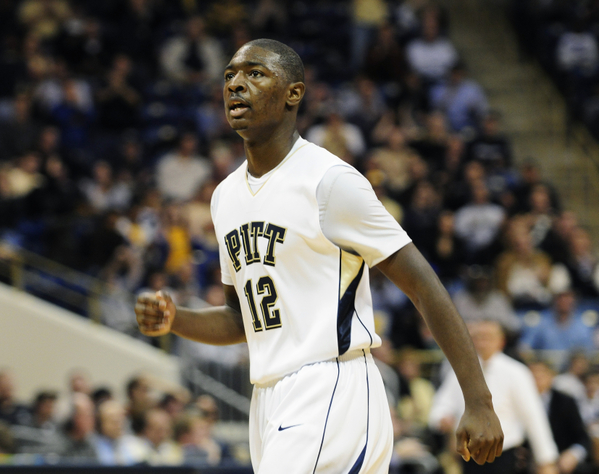
Ashton Gibbs could be an all-Big East performer
7) Ashton Gibbs, Pittsburgh– There are flaws in Gibbs’ overall game: any time a guard averages 1.8 APG in just under 35 MPG, his skills as a distributor are probably not overwhelming. Pitt head coach Jamie Dixon may have to play Travon Woodall at the point more often than he’d like this season because of that very fact. Gibbs’ defense also isn’t superb. But few in the country can get as hot as Gibbs scoring the basketball. Blessed with a quick release and unlimited range, Gibbs will be the #1 weapon on a balanced Pitt scoring attack in 2010-11. The most improved player in the conference last season, Gibbs has the offensive repertoire to score nearly 20 points per contest for the Panthers. His three-point percentage of 44% as a freshman is much more likely to be repeated than his 39% clip of his sophomore year. There’s no doubt Gibbs can light it up on occasion, but scoring efficiency, as well as improvements in other facets of his game, will be necessary for Pitt to reach their first Final Four since 1941.
8) Jeremy Hazell, Seton Hall– Where to rank Jeremy Hazell was one of the biggest challenges I encountered making this list. I’ve seen him do some incredible things on the court, single handedly bringing the Pirates back from nearly insurmountable deficits when he finds the right shooting stroke. Averaging over 20 PPG in the Big East is nothing to sneeze at, even if that number is in large part a result of former coach Bobby Gonzalez’ high possession strategy. In a two game stretch against West Virginia and Syracuse last year, Hazell attempted 64 shots, so it’s fair to conclude he can win you games with his shot and lose you games at the same time. There’s seemingly no heat check for this senior. Hazell’s long wingspan and good hands make you think he could be a solid defender, but he often becomes lazy on that end. Hazell also needs to work on penetration and creating his own shot rather than relying on catch-and-shoot plays. He can become too predictable and easy to defend with such an unbalanced offensive game. Even if the defense picks up on that and he’s covered, it really doesn’t matter: Hazell will shoot anyway. Still, make no bones about it, his return to The Rock for a senior campaign gives new coach Kevin Willard a legitimate shot of dancing in March. He’s that explosive of a scorer.
9) Chris Wright, Georgetown– Wright and fellow Hoya Austin Freeman will form one of the best 1-2 backcourt punches in the nation next season. Fairly inconsistent for most of his junior season, Wright really turned on the jets in March, scoring in double figures every game and probably would have garnered Big East Tournament MVP honors had Da’Sean Butler not gone all Superman again. He was also the only one seemingly interested in preventing Georgetown from being embarrassed in the first round of the NCAA Tournament. Wright has a strong body and is a sneaky good athlete. His jumper has been just average throughout his Hoya career, but the solid mechanics gives evaluators hope it can drastically improve as a senior. Wright excels defensively, providing JTIII with max effort on every possession and is a reliable free throw shooter, an imperative strength for a point guard. The Hoyas won’t have much in the way of backcourt depth after Wright, Freeman and Jason Clark unless freshman Markel Starks makes an impact right away, so 35-37 MPG may be in the cards again for Wright.
10) Gus Gilchrist, South Florida– An ankle injury in mid-December derailed Gilchrist’s sophomore season, but prior to the injury there were few more productive big men in the conference. The inside force working alongside dynamite scorer Dominique Jones, Gilchrist scored 18 or more points and grabbed seven or more boards in six of the Bulls first eight games. Utilizing a huge 6’10, 235 pound frame to bully over defenders, containing Gilchrist was certainly a chore for his overwhelmed opponents. Still, it’s worth noting that none of those opponents reached the NCAA Tournament, and when Gilchrist did return from the injury in mid-February, his statistics dipped substantially against Big East foes save a 21/6 against woeful Providence. It’s far from a sure thing Gilchrist takes the Big East by storm as the number one option in Tampa. He absolutely has the capabilities, the body and the potential, though. Great size, toughness and physicality in the paint all help Gilchrist, but it’s rounding out his game with a constantly improving shooting stroke that has USF fans drooling over what could be a breakout season.
Read the rest of this entry »































